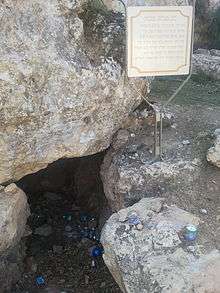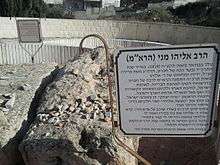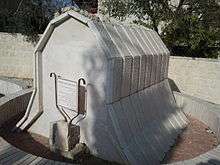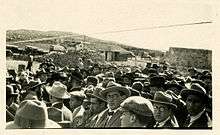Old Jewish cemetery, Hebron
The old Jewish cemetery in Hebron, is located to the west of the Tomb of Machpela on a hill and has been used as a Jewish cemetery for hundreds of years, as attested to by Ishtori Haparchi, who noted a Jewish cemetery in the area in 1322. Other sources indicate the cemetery being mentioned in a letter dated to 1290.[1][2]





Among the prominent rabbinical sages and community figures buried in the cemetery include Rabbi Eliyahu de Vidas known as the Reshit Hokhma, Rabbi Abraham Azulai, Rabbi Solomon Adeni, Rabbi Elijah Mizrachi, Rabbi Chaim Hezekiah Medini known as the Sdei Chemed, Rabbi Judah Bibas, Rabbi Haim Rahamim Yosef Franco, Rabbi Hillel Moshe Gelbstein, Rabbi Shimon Menashe Chaikin, and Menucha Rochel Slonim. Menachem Mendel of Kamenitz, the first hotelier in the Land of Israel,[3] references his visit to the grave of Eliyahu de Vidas in his 1839 book Sefer Korot Ha-Itim.[4] He states,
"here I write of the graves of the righteous to which I paid my respects." After describing the Cave of Machpela and the tombs of such Biblical figures as Ruth and Jesse, Othniel Ben Knaz and Abner Ben Ner, he reports, "I also went to a grave said to be that of the Righteous Rav, author of "Reshit Hokhma."
During the Jordanian period (1948-1967), the cemetery was intentionally destroyed and the site was cultivated by Arab residents for growing produce.[5] Around 4,000 tombstones were removed[6] and used for construction purposes.[5]
In the aftermath of the 1967 Six-Day War, Israel convened an inter-ministerial investigating committee to determine the scope of the desecration to Jewish holy sites under Jordanian rule. A local resident declared that before he ploughed the cemetery, a Muslim priest gave him permission "to clean away the graves of the Jews." A former member of the Hebron city council testified that a prominent Palestinian Arab councilor told him that the Jewish cemetery had been destroyed by direct order of the Jordanian government.[6]
After Jews returned to Hebron, they requested that the old Jewish cemetery be reopened. As it was located in a hilly residential area opposite Hebron's main market, initially the Israeli government prohibited the cemetery from being used.


The cemetery was re-opened for civilian use once again in 1975 with the untimely death of a local baby.[7] Baruch Nachshon, a noted hasidic artist and his wife Sarah gave birth to a baby boy named Avraham Yedidya who died six months later of crib death. According to Hebron Jews by Prof. Jerold S. Auerbach,
...His parents decided to bury him in the old Jewish cemetery in Hebron where no Jew had been buried since 1929. Israeli government officials, eager not to further provoke Hebron Arabs, refused permission... On the day of the funeral, Israeli soldiers blocked the road to the Hebron cemetery. After more than an hour of waiting, Sarah Nachshon wearied of the impasse... Returning to her car, she cradled her dead son in her arms and began to walk past the military blockade... several soldiers, moved by a grieving mother's unyielding determination, volunteered to drive her... [8]
Following the burial, the community made efforts to clean up the cemetery. Prof. Ben Zion Tavger, a Russian-Jewish physicist and refusenik who moved to Hebron initiated the refurbishing efforts in the mid 1970s. In time, refurbished tombstones were installed bearing the names of original community members.[9] Since then the site has both attracted visitors from around Israel as well as being targeted by vandalism.[10][11]

The cemetery also contains four mass graves with the remains of 59 victims of the 1929 Hebron massacre. A corner of the cemetery contains the remains of several Torah scrolls and Jewish prayer books which were torn up and set alight on the eve of Yom Kippur on October 3, 1976, at the Cave of the Patriarchs by rioters.[12]

Every year hundreds of members of the Chabad Lubavitch hasidic movement attend the anniversary of the passing of Menucha Rochel Slonim, a granddaughter of the founder of Chabad, Rabbi Shneur Zalman of Liadi and a matriarch of the Hebron Jewish community.[13] After a visit to the cemetery, a festive meal and gathering is held attracting top rabbis from around the country.[14][15][16][17][18]
A small synagogue and learning center was established in a historic building atop the cemetery called the Menucha Rochel kollel.[19]
It was the tradition of the Hebron community not to engrave names on tombstones.[20] Due to the expulsion of the community and subsequent vandalism of the cemetery, the exact identification of many plots were lost.[21][22]In 2016 a map was discovered that identifies the location of the graves.
References
- "Israeli Ministry of Foreign Affairs".
- "History & Overview of Hebron | Jewish Virtual Library". www.jewishvirtuallibrary.org. Retrieved 2016-02-21.
- "The first Holy Land hotelier". The Jerusalem Post | JPost.com. Retrieved 2016-01-11.
- ""Book of the Occurrences of the Times to Jeshurun in the Land of Israel" by David G. Cook and Sol P. Cohen". repository.upenn.edu. Retrieved 2016-01-11.
- Sherute ha-hasbarah 1967, p. 30
- Mandel 1969, p. 117
- "Sarah Nachshon - A Modern-Day Matriarch". www.chabad.org. Retrieved 2016-02-21.
- Auerbach, Jerold S. (2009-07-16). Hebron Jews: Memory and Conflict in the Land of Israel. Rowman & Littlefield Publishers. ISBN 9780742566170.
- al-Kuwayt 2003, p. 59
- Hevron Cemetery Desecrated Over Sabbath, Arutz Sheva, September 30, 2007. Retrieved: December 31, 2012.
- "Hevron Cemetery Desecrated Again". Arutz Sheva. Retrieved 2016-02-21.
- Alon 2004, p. 160
- ""Walk Between the Raindrops" - How Menucha Rochel Slonim United Hebron". the Jewish Community of Hebron. Retrieved 2016-02-21.
- "Hebron matriarch Menuha Rochel still inspires 128 years later". The Jerusalem Post | JPost.com. Retrieved 2016-02-21.
- "Yohrtzeit of Rebbetzin Menucha Rochel - Shturem.org Taking The World By Storm". www.shturem.org. Retrieved 2016-02-21.
- "Chof Daled Shevat – Yarzeit of Menucha Rochel Slonim". Chabad of Hebron. Archived from the original on 2016-02-16. Retrieved 2016-02-21.
- "Hebron's New Menucha Rochel". collive. Retrieved 2016-02-21.
- "100's Attend Memorial for Rabbanit Menucha Rachel Slonim • CrownHeights.info - Chabad News, Crown Heights News, Lubavitch News". CrownHeights.info - Chabad News, Crown Heights News, Lubavitch News. Retrieved 2016-02-21.
- "Observing the Yahrzeit of Menucha Rochel Slonim - Latest News Briefs - Arutz Sheva". Arutz Sheva. Retrieved 2016-02-21.
- "Gesher". www.pikholz.org. Retrieved 2016-02-21.
- "Newly Discovered Map Offers Clues to Ancient Hebron Cemetery". the Jewish Community of Hebron. Retrieved 2016-02-21.
- "נמצאה מפת בית עלמין חב"ד בחברון". הישוב היהודי בחברון. Retrieved 2016-02-21.
Bibliography and External links
- al-Kuwayt, Jāmi'at (2003). Journal of Palestine Studies, Volume 33. Institute for Palestine Studies and Kuwait University. Retrieved December 31, 2012.CS1 maint: ref=harv (link)
- Alon, Mati (2004). The Unavoidable Surgery. Trafford Press. Retrieved December 31, 2012.CS1 maint: ref=harv (link)
- Mandel, Morris; Gartenberg, Leo (1969). Israel: the story of a miracle. Jonathan David. Retrieved December 31, 2012.CS1 maint: ref=harv (link)
- Sherute ha-hasbarah (1967). Jordanian belligerency: a review of Jordan's policies towards the state of Israel. Israel Information Services. Retrieved December 31, 2012.CS1 maint: ref=harv (link)
- Genesis 23:14-20
- Photos of the Old Jewish Cemetery of Hebron
- Video of the Old Jewish Cemetery of Hebron from Vimeo
- Video of the Old Jewish Cemetery of Hebron via YouTube
- Auerbach, Jerold S. (2009) Hebron Jews: Memory and Conflict in the Land of Israel. ISBN 978-0-7425-6617-0
- Hebrew Wikipedia article on the cemetery
- Schematic view of the old Hevron Cemetery
| Wikimedia Commons has media related to Hebron Jewish cemetery. |